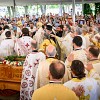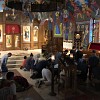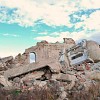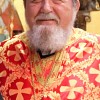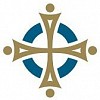Serbian Version
Fr. Vasilije Vranic
A Reflection on the Arrondation of the Constitution of the Serbian Orthodox Church in North and South America
Ten years ago, on May 15, 2009, Prof. Dr. Kosta Cavoski, an eminent professor of law at the Belgrade University’s Law School, published a critique of the then newly-adopted Constitution of the Serbian Orthodox Church in North and South America (“Нове невоље у Цркви“, Печат 63, 15. мај 2009.). The adoption of the new Constitution was the final administrative-legal step in overcoming the schism which had plagued the Serbian Orthodox Church since 1963. Canonical and hierarchical unity was achieved in 1992 between the Serbian Orthodox Church in America and Canada (established in 1921 by the Holy Assembly of Bishops) and Serbian Orthodox Metropolitanate of New Gracanica – Diocese of the USA and Canada (established in 1992 by the Holy Assembly of Bishops; previously in schism known as the “Free USA-Canada Diocese”). However, these two parallel entities each had their own respective constitutions and were governed jointly from 1992 to 2009 under the umbrella of the “Transitional Regulations” promulgated by the Holy Assembly of Bishops in 1992.
Reflecting on the adoption of the new Constitution, Prof. Cavoski was particularly troubled by the creation of the Serbian Orthodox Church in North and South America (2007) as a legal entity with its own foundational documents – a “constitution,” which according to him anticipated a future split of the Serbian Orthodox Church on the American continent and made it more easy for separatists to split the Dioceses of the Serbian Orthodox Church in the Americas, from the rest of the Serbian Orthodox Church.
Prof. Cavoski eloquently argued that there can be only one Constitution in the Serbian Orthodox Church, that of the Patriarchate, which governs the Serbian Orthodox Church as a whole. He further argued that the introduction of a constitution for only a part of the territory of the Serbian Orthodox Church was a novel concept, unsupported by the extant legal and administrative order of the Serbian Orthodox Church, which might eventually lead to a schism from the rest of the Serbian Patriarchate.
Prof. Cavoski’s criticisms were among many other legal and administrative shortcomings that this Constitution had. Recognizing these potentially destructive deficiencies, the Holy Assembly of Bishops of the Serbian Orthodox Church, as the highest and the only legislative body of our Church, decided to act on them at its regular meeting in May 2018.
In order to secure the assets and the legal position of the Serbian Orthodox Dioceses in the United States of America, the Holy Assembly decided that it was necessary to carry out a legal arrondation, i.e., to officially limit the geographical scope of the existing Constitution governing the Serbian Orthodox Church on the American continent.
It is important to note here several crucial points:
The arrondation of the Constitution of the Serbian Orthodox Church in North and South America was carried out at the regular meeting of the Holy Assembly of Bishops of the Serbian Orthodox Church at its regular session in the Patriarchate of Serbia in May of 2018, based upon a formal proposal and motion made by the three Bishops from the USA. According to canon law of the Orthodox Church in general, and the governing documents of the Serbian Orthodox Church as a whole, the Holy Assembly of Bishops is the highest legislative authority. Therefore, the Holy Assembly was fully and unequivocally within its right to promulgate the arrondation, especially since the arrondation was proposed by the Bishops from the affected territories. According to the canons of the Orthodox Church in general and the constitutional provisions of the Serbian Orthodox Church, an arrondation of a diocese can take place only at the proposal of the ruling bishop or with his consent.
The Episcopal Council of the Serbian Bishops in North and South America (3 bishops in the USA, 1 bishop in Canada, and 1 bishop in South America) all took part in the session of the Holy Assembly in May 2018, when the arrondation was promulgated.
From a legal standpoint, the arrondation is not a substantive change or amendment to the local Constitution, but merely a re-definition of its legal boundaries.
Whereas our local Constitution no longer includes territories of Canada and South-Central America, the highest hierarchical body of our Church on the American continent – the Episcopal Council – remains unchanged. It still numbers among its members all five bishops: three bishops from the USA, one bishop from Canada, and one bishop from South America.
The arrondation of the Constitution in May 2018 to cover only the Dioceses in the USA ought not be blamed for the exclusion of the Diocese of Canada and the Diocese of Buenos Aires and South-Central America from its legal territory. Neither diocese was de facto ever subject to the Constitution of the Serbian Orthodox Church in North and South America. The Diocese of Canada has enjoyed administrative autonomy since 1995, while the Diocese of Buenos Aires and the South-Central America was formed several years ago, i.e., years after the adoption of the Constitution and has never used the Constitution as its governing document. The Diocese of South-Central America has used the main Constitution of the Serbian Orthodox Church as its governing document and will continue to do so until it promulgates its own Statute.
As regards the Diocese of Canada, it adopted its own Statute as its governing document back in 1993. The explanation provided by the representatives from Canada for the drafting of the Statute was that the Canadian legal system does not allow for a constitution adopted in the United States of America to be the highest governing document for a non-profit legal entity in Canada. The Holy Assembly of Bishops, at its meeting at the Patriarchate in 1995, acknowledged the argument and promulgated the Statute. Following the adoption of the Constitution of the Serbian Orthodox Church in North and South America in 2007 (promulgated in 2009), the Statute was acknowledged as the governing document for the Diocese of Canada. Therefore, de facto the Diocese of Canada is governed by its own Statute and not by the Constitution.
An additional challenge for the legal and administrative order of the Church on this continent was the founding of the Diocese of South-Central America. Two problems needed to be addressed: (i) difference in language for official and legal communication, and (ii) differences in the legal systems.
An obvious and serious obstacle is the linguistic difference. The legal system of North America uses English as its official language, while the Latino-American countries use predominantly Spanish and some Portuguese.
Moreover, the provisions of the Constitution seem to be unenforceable in the Diocese of Buenos Aires and South-Central America, given the fact that its legal framework does not account for the complex legal situation in that Diocese. The Diocese of South-Central America covers 45 countries with very diverse legal codes and judicial systems (12 countries in South America, 7 countries in Central America [including Mexico], and 26 countries in the Caribbean).
The arrondation of the Constitution in May 2018 is also designed to provide the necessary legal protection for the assets of the Serbian Orthodox Church in the USA. Due to the American civil justice system and liability exposures for all churches and related church organizations, the Episcopal Council has sought expertise from insurance and legal experts who insure and provide risk protection for religious organizations. In creating the voluntary property casualty insurance program through Guide One Insurance Company and insurance agent, Independent Insurance Systems of Ohio, the church is further trying to foster expert protection for our parish communities at local, diocesan, and national levels. The program provides for comprehensive property coverages for our physical churches and personal property. Moreover, the program, also offers a wide spectrum of coverages for other areas of liability for clergy, parish boards, parish administrative staff members, parish schools and the like from potentially destructive lawsuits, which are so prevalent in the American justice system. Due to various statutory and regulatory requirements, insurance companies can only offer insurance policies to legal entities and persons in the USA. Therefore, clergy and church employees from dioceses outside of the USA cannot be covered by this insurance program.
The arrondation therefore seeks to shield the church from potential lawsuits that might originate in Canada and South-Central America. Such lawsuits could have serious financial repercussions for the Dioceses in the USA, since the 2009 Constitution of the Serbian Orthodox Church in North and South America accepted the entire North and South American continents as its legal/jurisdictional territory. With the territorial provisions of the 2009 Constitution, but no real jurisdiction, the Central Council of our Church did not have a mechanism to secure the assets of the Serbian Orthodox Church in the USA. The arrondation adopted in 2018 addresses that problem.
Thus we come back to the initial criticism that the existence of a Constitution for a large geographically defined territory, such as the American continent, may lead to a split and schism within the Church. If we accept that premise (which I personally do not, since well-drafted governing document always precludes such a scenario), then the legal arrondation and the reduction in the jurisdictional scope of the current Constitution certainly ought to be viewed as a welcome move in a positive direction. One must note that in the updated version of the Constitution, the word “church” is replaced by “dioceses”. This very small, but nonetheless very important change in terminology ensures that the ecclesial structure in the USA is not independent from the Serbian Patriarchate and that no one is trying to create a new non-Serbian church. Moreover, the current terminology is fully in line with the provisions of the main Constitution of the Serbian Orthodox Church. As Prof. Cavoski aptly noted, the main Constitution of the Serbian Orthodox Church in its Article 5, recognizes only the following legal entities: “The Patriarchate, Dioceses, Church Congregations, Monasteries, Endowments, Foundations or Funds, and certain churches.“ Thus, the current main Constitution of the Serbian Orthodox Church is in full agreement with the modifications of the name – Serbian Orthodox Dioceses in the USA. The terminological modification ought to be viewed as a correction of a past imprecision and a move to preempt any separatist tendencies. Time will tell, but perhaps even the governing document of the Serbian Orthodox Dioceses in the USA will be changed to a Statute or another type of document, which may more clearly indicate the inalienable unity between the Dioceses of the Serbian Orthodox Church in the USA with our Patriarchate and the Serbian Orthodox Church as a whole.
The corrected document is certainly far from perfect, but it is a step forward in the creation of a better-defined highest legal document of the Serbian Orthodox Dioceses in the USA. An expert Legislative Committee has been appointed by the Episcopal Council as was reported at the last Sabor in July 2019. This committee faces long and arduous work in its future and will certainly seek input from all levels of our Church, both at the Diocesan and parish levels in the USA, as well as from the Patriarchate and other Church institutions in Serbia.
Nonetheless, it is my personal conviction that the effort will be, first and foremost, to the glory of God and for the benefit of the Serbian Orthodox Church as a whole and under the constant spiritual supervision and protection of our great Holy Fathers and Enlighteners: St. Sava, St. Nicholai, St. Varnava, St. Mardarije, and St. Sebastian.
Rev. Vasilije Vranic, Ph.D., is the chair of Canon Law at St. Sava Serbian Orthodox School of Theology in Libertyville.
|
| |||||||||||||
